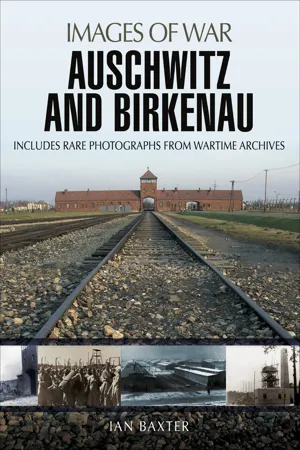![]()
Phase II
Birkenau
(Death & Labour Camp)
Although the improved killing facility at Auschwitz had more or less been achieved with the use of Zyklon B crystals, Höss had become increasingly concerned at the amount of Russian PoWs that would be sent to the camp and pass through the crematorium. By September he had received news that the Germans had already captured an estimated 3 million Soviet prisoners. Some 100,000 of them were transferred from the Army to the SS in September, and many were earmarked for Auschwitz. According to a report, Himmler had ordered Hans Kammler to inform the commandant of Auschwitz that the long-awaited giant PoW camp at Auschwitz would be constructed next to the parent camp. Its construction was to house many of the new Soviet PoWs and the environment in which they were to be placed would ensure that large numbers of them would perish.
The site chosen for the extension of Auschwitz was near the Polish village of Brzezinka. This marshy tract of land surrounded by birch woods was situated nearly 2 miles west of the main camp. Although there had never been any concrete plans to construct a massive PoW camp on the land, as a precaution the houses of the small village of Brzezinka were cleared by the SS in July and all its inhabitants relocated elsewhere. The Germans renamed the area Birkenau.
The task of designing Birkenau was left in the capable hands of the newly appointed chief of the Auschwitz construction office SS-Hauptsturmführer Karl Bischoff, and the 33-year-old architect SS-Rottenführer Fritz Ertl. The total budget for the construction was to be 8.9 million Reich Marks. The projected number of prisoners to be housed in the camp was 97,000. It was planned that Birkenau would be divided into a two-part camp, with the smaller part of only 17,000 inmates located in a quarantine camp. The accommodation was to be very overcrowded and initial plans were for one barrack block to contain 550 inmates. This amount was soon altered to a final figure of 744.
In the quarantine camp it was planned that there were going to be two delousing stations, two kitchens, thirty barracks each accommodating 744 men, five toilet barracks, and five washrooms. In the main part of the installation, the camp was to be divided into twelve camps, each with twelve barracks, one kitchen, one toilet barracks, and one washroom. All inmates were to be housed in 174 barracks, each barrack subdivided into sixty-two bays, and each bay having a three bunk-bed system.
The size of the construction was to be on a scale that not even Höss could have envisaged. The whole area covered over eighty hectares. On a couple of occasions he actually visited the location on his own in order to try to formulate an impression in his mind on the sheer size of the area of land upon which the new satellite camp would be built. Following the example of the main camp, Höss had been entrusted with selecting inmates to build the Birkenau site. With so many Russian PoWs in captivity, he was ordered to use the vast pool of prisoners offered from the German Army. Höss received confirmation from Himmler’s office that the Russian PoWs would be used for slave labour to build the new camp.
In early October, Höss finally authorised the transportation order of his new Russian labour force. In total 10,000 Russian prisoners from Lamsdorf were to be marched to Auschwitz. The journey to the camp was one of complete horror.
Almost as soon as the Russian PoWs arrived in Auschwitz they were ordered to work. Those that were too weak were killed and disposed of in the crematorium, while the remaining prisoners were dragged from their barracks and marched the forty minutes to the Birkenau construction site. The first job was to dismantle the existing village and then start building the camp. The Russians had not been given any tools with which to demolish the houses. Instead they were required to pull down the buildings with their bare hands. The physical condition of the men was appalling, but they were still forced to work. All day long they laboured in freezing temperatures. First they had to level the ground, then drainage ditches had to be dug, and then finally the various brick barracks and prefabricated wooden horse stables had to be constructed. The speed of the work was of utmost importance, and within fourteen days the quarantine camp had been completed.
Throughout the building project at Birkenau, Höss was constantly updated with its progress. Regularly he was seen visiting the construction site, either by motor vehicle or on horseback. On numerous occasions he could be seen wandering around the building site discussing details of the construction programme with site managers and subordinates. He soon discovered, which came as no surprise, that the labour force had not been su...
